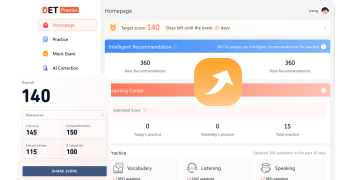デュオリンゴ英語テストの「読んでから話す」セクションをマスターする
Duolingo English Testは、自宅で英語力を評価するための便利で手頃な価格の方法です。他の標準化テストとは異なり、Duolingo English Testは、あなたのレベルやスキルに応じて形式が変わります。最も難しく重要な部分の一つが「Read, Then Speak」セクションです。このセクションでは、プロンプトを読んだ後、90秒間トピックについて話す必要があります。
この記事では、このセクションを攻略して会話力と表現力のサブスコアを向上させる方法をお教えします。
取り上げる内容は以下の通りです:
- 「Read, Then Speak」形式の理解
- 答える準備をする
- 回答の構成
- 回答の提供
- 回答の強化
- サンプル問題とデモ回答の導入
- 練習のコツとリソース

「Read, Then Speak」形式の理解
「Read, Then Speak」セクションは、Duolingo English Testの4つのスピーキングタスクの1つです。このセクションでは、「以下のトピックについて90秒間話してください。」という指示が表示されます。
この質問タイプでは、画面に書かれたプロンプトが表示されます。プロンプトを読んで回答を準備するのに20秒の時間が与えられ、その後、自動的に録音画面に進み、90秒間の回答を録音します。話している最中でもプロンプトを見ることができます。
プロンプトは通常、個人的な経験、意見、または好みに関することを求めます。例えば:
- お気に入りのレストランについて話してください。
- 困難な決断を下さなければならなかった時について議論してください。
- 楽しんでいる趣味について説明してください。
プロンプトには、回答のガイドとなる箇条書きのポイントも含まれることが一般的です。例えば:
- それはどこにありますか?
- どんな種類の料理を提供していますか?
- どれくらいの頻度で行きますか?
- なぜそれが好きですか?
あなたの回答は、会話力(Conversation)と表現力(Production)の2つのサブスコアに基づいて採点されます。会話力は、質問にどれだけうまく対応し、自分の考えを表現できるかを評価します。表現力は、語彙と文法を使って明確かつ正確に伝える能力を評価します。
答える準備をする
成功するための鍵は、プロンプトを素早く理解し、短時間で考えを整理することです。以下は、準備を助けるための戦略です:
- プロンプトを慎重に読み、主題と副題を特定します。例えば、プロンプトが「お気に入りのレストランについて話してください。」であれば、主題はお気に入りのレストランであり、副題はそれがどこにあるのか、どんな料理を提供しているのか、どれくらいの頻度で行くのか、そしてなぜそれが好きなのかです。
- 主題に関連する具体的な例を考えてみてください。例えば、お気に入りのレストランが自宅近くのタイ料理店なら、友人や家族と一緒に行った思い出深い時を思い出してみてください。
- 箇条書きのポイントをガイドとして使って回答を構成します。例えば、お気に入りのレストランを紹介するところから始め、それぞれの箇条書きポイントに順番に触れ、最後に主要なポイントをまとめる結論で締めくくります。
- 準備時間の20秒を有効に活用しましょう。重要なキーワードを見つけて、主要なポイントを覚えておくのに役立てましょう。また、最初の一文を練習して、自信を持ってスタートできるようにしましょう。
回答の構成
明確で論理的な回答構成は、スムーズで一貫性のある回答を提供するのに役立ちます。回答を構成するためのヒントをいくつか紹介します:
- 導入部、本体、結論を作成します。導入部では主題を簡単に紹介し、主要なポイントを述べます。本体では、各サブテーマについて詳しく話しながら主要なポイントを展開します。結論では、主要なポイントをまとめ、最終的なコメントで締めくくります。
- アイデアや文をつなぐための移行語句やフレーズを使います。例えば、「first」「second」「third」「next」「then」「finally」「also」「however」「for example」「in conclusion」などの言葉を使います。
- プロンプトのすべての部分に触れるようにします。どの箇条書きポイントもスキップしたり無視したりしないようにしましょう。副題について言うことがない場合は、それに簡単に触れて次に進むこともできます。例えば、「I don’t go there very often, but when I do, I always enjoy it.」と言うことができます。
- 主題に集中します。脇道に逸れたり、関係のない詳細に触れたりしないようにします。もし話が主題から外れていると感じたら、主要ポイントと箇条書きポイントに戻るようにします。
回答の提供
回答の提供は内容と同じくらい重要です。以下は、回答を明確かつ流暢に提供するためのテクニックです:
- 自然で明瞭に話すようにします。通常の話し方の速度とボリュームを使います。早すぎたり遅すぎたり、大声で話したり小声で話したりしないようにしましょう。言葉を正しく発音し、口ごもったり曖昧にしたりしないようにします。
- 多様な言葉や構文を使います。同じ言葉や文章を繰り返さないようにします。シノニムや反義語、またはパラフレーズを使って同じアイデアを異なる方法で表現します。幅広い語彙と文法構造を使って、あなたの熟練度と正確さを示します。
- 時間をうまく管理します。回答を話すのに90秒が与えられていますので、プロンプトと箇条書きポイントをカバーするのに十分な時間です。長すぎたり短すぎたりしないようにしましょう。時間内に回答を終えた場合は、ポイントを補足するために追加の詳細や例を加えることができます。時間切れの場合は、迅速に回答を締めくくります。
- 様々なイントネーションと強調を使います。単調な声や平坦な声で話さないようにします。音程、ボリューム、ストレスを変えて意味や感情を伝えます。文中の重要な言葉やフレーズを強調します。質問や陳述を示すために、上昇と下降のイントネーションを使います。
回答の強化
回答を際立たせ、評価者に印象付けるために、いくつかの戦略を使って回答を強化し、会話スキルを示すことができます。以下はその方法です:
- 修辞的な質問を使います。修辞的な質問とは、自分や聞き手に対して質問を投げかけるが、答えを期待しない質問のことです。それは聞き手を引き込み、自分の考えを表現したり、ポイントを強調したりするために使われます。例えば、「Who doesn’t love Thai food, right?」や「What could be better than that?」と言うことができます。
- 逸話や物語を使います。逸話や物語とは、個人的な経験や出来事に関する短くて興味深い話のことです。それはポイントを説明し、例を挙げたり、ユーモアを加えたりするために使われます。例えば、「One time, I ordered the spiciest dish on the menu, and I regretted it so much. My mouth was on fire, and I had to drink three glasses of water to cool it down.」と言うことができます。
- 意見や感情を使います。意見や感情とは、トピックに対する個人的な見解や感情のことです。それはあなたの個性、視点、態度を示すために使われます。例えば、「I think Thai food is the best cuisine in the world.」や「I feel so happy and relaxed when I go to my favorite restaurant.」と言うことができます。
サンプル問題とデモ回答
これまでに紹介したコツや戦略を適用する方法をよりよく理解するために、「Read, Then Speak」セクションのサンプル問題とデモ回答を見てみましょう。
サンプル問題:
Discuss a time when you had to make a difficult decision.
What was the situation?
What choices were available to you?
Why did you make the decision you did?
デモ回答:
Well, I’d say one of the toughest decisions I’ve ever had to make was figuring out where I wanted to go to college after I finished up high school. I had gotten accepted to a few different schools and it definitely wasn’t an easy choice to make.
Let’s see, first off, I should probably give you some background real quick on the different colleges I got into. There was this small liberal arts college pretty close to home that I applied to. It was a nice little school. Then there was this huge state university that was like 5 hours away – it was really big with tons of students. And last, I applied to this Ivy League school all the way on the other side of the country. I had worked really hard to get awesome grades and test scores in high school so I could have some good options to choose from.
So each school had their own pros and cons that I had to think about. The small college was nearby and I already knew some kids going there. But it didn’t have the big name like the Ivy League did. The state school was a lot more affordable but it was so big I worried I wouldn’t get enough personal attention from professors. And the Ivy League school was super prestigious, but way more competitive and expensive too.
After visiting all 3 campuses, I decided the small liberal arts college was the best option for me. I really liked the small class sizes and how tight-knit the community felt. They also gave me a great financial aid package that made it possible to afford. I knew I’d get to work closely with professors and get individualized attention there, and that was huge for me.
So in the end, I went with my gut telling me the small school was the right call. I didn’t want to pass up the chance to really get mentored and be part of a community just because the Ivy League name carried more weight. And I’m stoked with my choice – I’ve gotten to have experiences at this school I don’t think I would’ve had anywhere else. So for me, I’m happy with my decision.
練習のコツとリソース
スピーキングスキルを向上させ、「Read, Then Speak」セクションの準備をする最良の方法は、定期的かつ継続的に練習することです。以下は、練習に役立つ方法とリソースです:
- テスト環境をシミュレートします。実際のテストの条件をできるだけ再現します。ウェブカメラとマイクを備えたコンピュータを使用し、静かで快適な場所を見つけてテストを受けます。プロンプトを読むのに20秒、回答を話すのに90秒のタイマーを設定します。自分自身を録音して、自分のパフォーマンスを聞きます。強みと弱みを特定し、それらを改善するために取り組みます。
- オンラインリソースを利用します。多くのオンラインリソースがスピーキングスキルを練習し、Duolingo English Testの準備を助けてくれます。例えば、公式DETウェブサイトを使用して、テスト形式、スコアリング、およびヒントについて学ぶことができます。また、Duolingo English Testの練習問題バンクを使用して、テストに慣れることもできます。
詳細はこちらをご覧ください: DET Preparation Strategies
DETのヒントをお探しですか?こちらで確認してください:https://www.detpractice.com/category/pro-test-tips/
無料でDET問題バンクにサインアップして、今日から練習を始めましょう。






